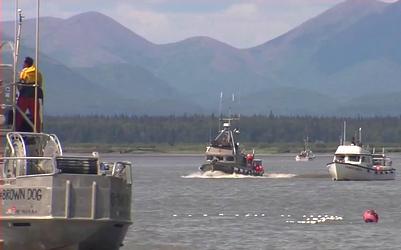
WASHINGTON, DC, December 16, 2014 (ENS) – President Barack Obama today designated the waters of Bristol Bay as off limits to oil and gas leasing for exploration, development or production. This action safeguards one of the nation’s most productive fisheries and preserves an ecologically rich area of the Bering Sea that is vital to the commercial fishing and tourism economy and to Alaska Native communities.
The eastern-most arm of the Bering Sea, Bristol Bay is 250 miles long and 180 miles wide at its mouth. Many of Alaska’s major rivers flow into the bay, and all five species of Pacific salmon: pink, chum, sockeye, coho and king, return to Bristol Bay to spawn in these rivers.

Bristol Bay is at the heart one of the world’s most valuable fisheries, helping to provide 40 percent of America’s wild-caught seafood and support a $2 billion annual fishing industry.
The beautiful and remote area is also an economic engine for tourism in Alaska, driving $100 million in recreational fishing and tourism activity every year.
Bristol Bay hosts the largest runs of wild sockeye salmon in the world, and provides important habitat for many species, including the threatened Stellar’s eider, sea otters, seals, walruses, Beluga and Killer whales, and the endangered North Pacific Right Whale.
Today’s decision to withdraw the area from all future oil and gas leasing extends indefinitely a temporary withdrawal that President Obama issued in 2010 and was set to expire in 2017.
This action builds on decades of local efforts to protect Bristol Bay from oil and gas development by Alaska Native tribes and organizations, as well as local seafood and tourism businesses that create jobs and strengthen Alaska and the nation’s economy.
It also honors the legacy of Alaska residents like Harold ‘Harvey’ Samuelsen, a salmon fisherman who is legendary for his lifelong dedication to Bristol Bay and to creating economic opportunities for Alaska Native and rural communities.
The North Aleutian Basin Planning Area that includes Bristol Bay consists of 32.5 million acres, a portion of which was leased in the mid-1980s but never developed due to litigation.
The Bush Administration set in motion a new lease sale for 2011 that would have opened approximately 5.6 million acres – about one-fifth of the planning area – for drilling.
In 2010, President Obama temporarily withdrew the Bristol Bay area from oil and gas development, exercising his authority under section 12 of the Outer Continental Shelf Lands Act, which gives the President authority to withdraw offshore areas from potential oil and gas leasing.
President Eisenhower was the first to exercise this authority in 1960, withdrawing an area now included in the Florida Keys National Marine Sanctuary. Since then, presidents of both political parties have acted to withdraw areas of the Outer Continental Shelf from oil and gas leasing.
Secretary of the Interior Sally Jewell said, “Alaskans have been fighting to preserve Bristol Bay for decades. Today, we got it done.”
“Bristol Bay helps to produce 40 percent of America’s wild-caught seafood each year. It supports $2 billion every year in commercial fishing, and supports good jobs in sport-fishing and tourism,” said Jewell. “These waters are beautiful and valuable, and today’s action will ensure that future generations will be able to enjoy their bounty.”
Environmentalists are delighted with this protection.
Elizabeth Thompson, president of Environmental Defense Action Fund, said, “President Obama deserves the thanks of everyone in America for his action to prohibit oil and gas leasing in Bristol Bay, Alaska. Bristol Bay is a special place – a sensitive and precious natural resource that must be preserved for its abundant fishery, its incomparable beauty, and its vast and productive habitat. In protecting the Bay ecosystem from drilling, the President has delivered once again on his promise to protect the special and irreplaceable natural treasures of the American landscape.”
Even Alaska’s Republican Senator Lisa Murkowski did not object, saying, “Given the lack of interest by industry and the public divide over allowing oil and gas exploration in this area, I am not objecting to this decision at this time. I think we all recognize that these are some of our state’s richest fishing waters.”
But Murkowski criticized the Obama Administration for putting conservation ahead of oil production in Alaska.
“It is incredibly frustrating that this administration looks at Alaska – with oil production at a fraction of the level it could be at, and with low oil prices about to force steep across-the-board budget cuts – and decides that conservation is our most pressing need,” Murkowski said.
“We are not asking to produce everywhere – but right now, we are not being allowed to produce anywhere. Despite strong support, we are seeing development blocked in the Chukchi, the Beaufort, in NPR-A, and on the Coastal Plain. What we need are decisions to open lands and waters in Alaska, not the familiar and frustrating pattern of shutting everything down.”
Under the Outer Continental Shelf Land Act of 1953, the Department of the Interior develops a new leasing program every five years for energy development in federal offshore waters.
The current Five Year Program for 2012-2017, which expires in August 2017, schedules 15 potential lease sales in six planning areas with the greatest resource potential, including more than 75 percent of the estimated undiscovered, technically recoverable oil and gas resources in federal offshore waters.
The Bureau of Ocean Energy Management is currently developing the 2017-2022 program, which includes opportunities for public comment.
Copyright Environment News Service (ENS) 2014. All rights reserved.
